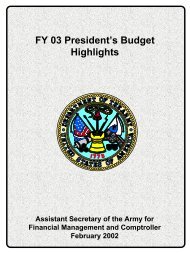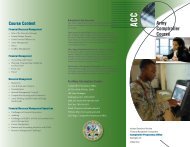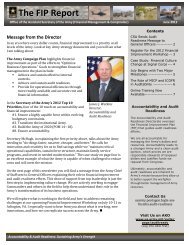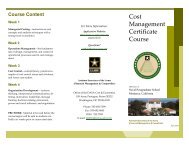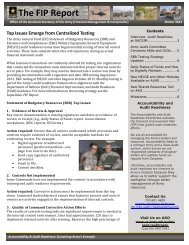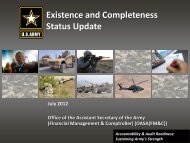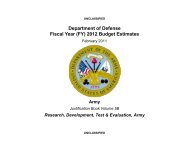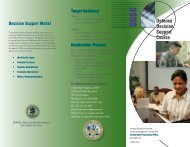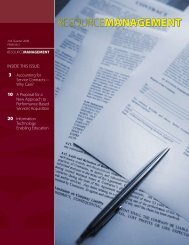Army Audit Readiness Strategy FY 2013 - Army Financial ...
Army Audit Readiness Strategy FY 2013 - Army Financial ...
Army Audit Readiness Strategy FY 2013 - Army Financial ...
Create successful ePaper yourself
Turn your PDF publications into a flip-book with our unique Google optimized e-Paper software.
<strong>FY</strong> <strong>2013</strong> <strong>Army</strong> <strong>Audit</strong> <strong>Readiness</strong> <strong>Strategy</strong><br />
To achieve the OUSD(C) FIAR Guidance objectives, the USD(C) has identified two major<br />
financial improvement priorities:<br />
Budgetary information, as contained in the SBR.<br />
Information regarding the existence and completeness of mission critical assets.<br />
OUSD(C) has formulated a comprehensive strategy with a critical path that allows DoD to focus<br />
on improving the information most useful to management, while moving closer to the ultimate<br />
goal of achieving and sustaining auditability. The critical path includes:<br />
Appropriations Received <strong>Audit</strong><br />
SBR <strong>Audit</strong><br />
Mission Critical Assets Existence & Completeness (E&C) <strong>Audit</strong><br />
Full <strong>Audit</strong> except for Legacy Asset Valuation<br />
Full-Scope <strong>Financial</strong> Statement <strong>Audit</strong><br />
Each DoD Component must perform the activities prescribed by the FIAR Guidance to address<br />
each of the OUSD(C) priority areas. DoD Components have the ability to identify various<br />
assessable units, which are smaller, more manageable combinations of material transactions or<br />
financial statement line items. OASA(FM&C) is responsible for defining assessable units and<br />
ensuring adequate coverage of all OUSD(C) priority areas, as defined in the FIAR Guidance.<br />
The FIAR Guidance defines a series of standardized phases that all reporting entities must follow<br />
to achieve audit readiness. The methodology currently focuses on the identification and<br />
implementation of key control objectives (KCOs) and key supporting documents (KSDs).<br />
Meeting the OUSD(C)-defined KCOs, coupled with comprehensive risk assessments, allow<br />
reporting entities to effectively design or identify existing control points within their business<br />
environments. The identification and collection of KSDs allow reporting entities to better<br />
evaluate the effectiveness of controls, substantiate recorded account balances, and provide<br />
auditors with the supporting documentation required during an audit.<br />
Updates to the OUSD(C) FIAR Guidance in December 2011 included several significant<br />
changes. One of these changes is the full integration of requirements prescribed in Office of<br />
Management and Budget (OMB) Circular A-123, Appendix A, Internal Control Over <strong>Financial</strong><br />
Reporting. This integration will drive efficiency in the use of DoD’s resources to meet the<br />
objective of achieving an audit ready state. Other examples of changes include updates to key<br />
capabilities and capabilities measures and a list of audit “dealbreakers” that have prevented<br />
reporting entities from achieving audit readiness.<br />
The FIAR Guidance can be found on the OUSD(C) website here:<br />
http://comptroller.defense.gov/fiar/documents/FIAR_Guidance_2011.pdf<br />
2.3 <strong>Army</strong> Achievements to Date<br />
For more than a decade, the <strong>Army</strong> has worked to implement financial improvements and<br />
increase awareness of the importance of audit readiness throughout the organization. In<br />
October 1998, OASA(FM&C) published the first iteration of the <strong>Army</strong> FIP, then known as the<br />
Chief <strong>Financial</strong> Officer’s (CFO) Strategic Plan, which incorporated all known initiatives and<br />
Accountability & <strong>Audit</strong> <strong>Readiness</strong>: Sustaining <strong>Army</strong>’s Strength 3



